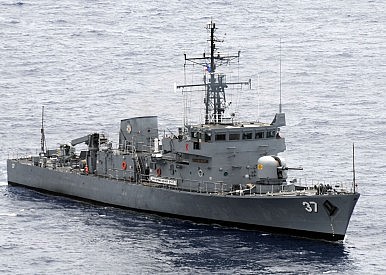Reports suggest a key Supreme Court ruling may be declared sooner than anticipated.

The Republic of the Philippines Navy patrol boat BRP Artemio Ricarte during the Balikatan exercises with the United States in 2009. Image Credit: U.S. Navy Photo
Over the weekend, local media outlets reported that the
Supreme Court of the Philippines may
finally decide that a new U.S.-Philippine defense pact is constitutional more
than a year after it was signed and before U.S. President Barack Obama touches
down next week in Manila
The Enhanced Defense Cooperation Agreement (EDCA) – a pact inked in April 2014 between Washington
and Manila that, among other things, would give U.S.
Though Philippine officials have been assuring outside observers
that EDCA’s approval is a question of when rather than if, many in Washington had hoped a decision would be made before
Obama attends the Asia-Pacific Economic Cooperation (APEC) meeting that Manila
Now sources suggest that the court will decide to uphold the
constitutionality of the pact before Obama’s trip as many had hoped. Sources
close to the judicial proceedings told
The Manila Times that the 82-page draft decision of Chief Justice Maria
Lourdes Sereno is expected to declare EDCA “not constitutionally infirm.”
These sources also added that the tribunal would discuss and
deliberate the draft decision on November 10 and that depending on whether or
not there are objections, there could be a vote either then or on November 16
on the eve of the APEC summit. Separately, a government official also told Reuters
that the administration expected a ruling in its favor before APEC.
If true, this would be a significant development both for
the Philippines Manila ’s
side (See: “A ‘New’ Philippine Naval Base in the South China Sea?”).
Getting EDCA’s issues resolved before Obama’s visit would
also no doubt inject some vigor into the bilateral relationship and ease U.S. U.S.
But while this would be a welcome development for the Aquino
and Obama administrations, there are still several lingering questions about
the news. First, it is unclear whether a decision would definitively resolve
all concerns by opponents of the pact, particularly the most contentious one
that EDCA is a new treaty that requires Senate concurrence by a two-thirds
majority, rather than an executive agreement in line with the 1951 Mutual
Defense Treaty as the Aquino administration suggests.
While several other reports are silent on these specifics,
the Manila Times article does cite sources as saying that the decision
states that Aquino has the authority to sign agreements as head of the
executive branch. If this is indeed the court siding with the Aquino
administration’s interpretation of EDCA as an executive agreement that does not
require Senate concurrence, that would constitute a huge victory. As of now, it
does not appear as if the Aquino administration has the necessary two-thirds
majority in the Senate. Meanwhile, Senator Miriam Defensor Santiago, one of the
chief opponents of EDCA, shows few signs of slowing her crusade against the
pact. This week, she said she intends to sponsor a Senate resolution restating
her view about the need for Senate concurrence.
It is also unclear what exactly accounts for the alleged
timing of the decision and the leaks about it. The Manila Times article
offers little in this regard except an anonymous source contending that the
Chief Justice may be trying to curry favor with the Aquino administration. Yet
it is far from certain that an early decision before Obama’s arrival as well as
news about it before hand would actually boost support for the pact rather than
undermine it. Following the news and true to form, opponents of EDCA have
already billed the timing of the decision as further proof that the Philippines
is kowtowing to its ally by ‘gifting’ the agreement to Obama.
Lastly, it is worth pointing out the obvious: that such
disclosures – particularly in democracies like the Philippines
All this merely confirms that while the importance of EDCA
to Philippine military modernization and the U.S.-Philippine alliance has
always been clear to both administrations, how exactly Manila will get to the
finish line continues to be much less so.

No comments:
Post a Comment
Note: Only a member of this blog may post a comment.